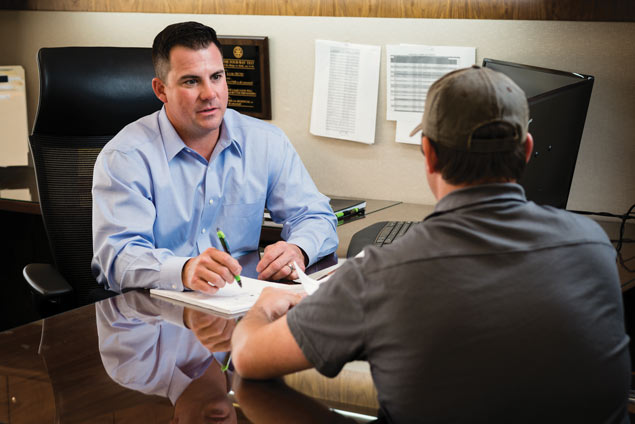
Photo by Shannon Richardson
Matt Cox, AgTexas Farm Credit’s Amarillo branch manager, reviews a customer’s business plan.
Times are lean for some farmers and ranchers, and the trend may continue for a few years.
“Hopefully, row crop farmers and livestock producers strengthened their balance sheets and made capital improvements when profit margins were better,” says David Ogletree, senior vice president of lending and field operations at Louisiana Land Bank. “And in times like these, when profit margins are thin, it pays to communicate with your lender more frequently.”
Despite leaner times, Louisiana Land Bank is not seeing significant financial stress among its customers.
“Our farmers and ranchers have been able to access operating loans and make payments,” Ogletree says. “However, should commodity prices continue their current trend, we expect less ability to meet financial obligations.”
Good communication builds relationships that last through good times and bad.”
- Matt Cox, AgTexas Farm Credit
On intensively managed dairy farms, it’s always a good idea for operators to keep in touch with their loan officer, says Brett Valentine, senior vice president at Ag New Mexico, FCS, in Clovis.
“Our producers struggle with depressed milk prices, but feed costs are at the lowest level in years,” he says. “Every challenge brings opportunity, and that’s where good communication between producers and lenders can make a difference.”
Ogletree and Valentine offer the following tips for communicating with your lender, and what to expect from the conversation.
Don’t procrastinate.
Farmers like to talk about yields, prices and expenses, but often avoid discussing the bottom line, especially when it’s in the red. Many put off contacting their lender, hoping their financial picture improves.
“We want farmers to know that we can have a conversation without negative consequences,” Ogletree says.
“The sooner we know about problems, the sooner we can find solutions,” Valentine adds.
Ask about restructuring.
If you need more time to make payments, ask to extend loan maturities. “We are seeing interest in restructuring as cash flow has diminished and the need for liquidity has come to the forefront,” says Valentine.
Be open to changing your business practices.
Find ways to cut expenses, avoid unnecessary purchases, seek help from financial experts, and use accrual accounting to assess your situation. In addition, Ogletree recommends finding new income sources.
“Louisiana farmers keep a lot of marginal farmland for personal use as hunting tracts, and this type of land is currently bringing a premium in the marketplace,” he says. “Are you willing to sell or lease nonearning assets to generate working capital or reduce debt?”
Step up communication with others.
Share concerns with your spouse, family members and partners. As Valentine says, “We’re surrounded by people with varying experiences and perspectives. Exposing your weaknesses can help you grow.”
Ogletree stresses the need to reach out to landlords: “Someone else may be willing to pay a higher rent, but the landlord needs to know that you are reliable and committed to a mutually beneficial relationship.”
Don’t lose hope.
Times have changed since the 1980s, when American farmers experienced massive financial distress. Most operators today maintain more equity.
“Farmers and ranchers are smarter and more efficient than ever,” Ogletree says. “In this age of new technology, you’re better equipped to grow and market your products.”
Provide any information that helps lenders analyze your financial situation.
As Ogletree says, “We’re looking for ways to help.”
– Nancy Jorgensen
Profitability, Liquidity, Solvency: Three Key Measures of Financial Health
Lenders concentrate on three main measures during challenging financial times: profitability, liquidity and solvency.
“It’s important for lenders to know our customers, but it’s just as important for borrowers to know what we look for from them,” says Matt Cox, branch manager for AgTexas Farm Credit Services in Amarillo. “Good communication builds relationships that last through good times and bad.”
Profit margins have deteriorated.
Before your next meeting with your lender, Cox suggests you answer these questions related to profitability.
- What’s your cost of production?
- Do you have a clear, concise marketing plan?
- Do you have a written business plan covering the next three to five years?
- Have you prepared a monthly cash-flow budget, and do you compare actual results?
- Do you maintain up-to-date records, including accrual-based balance sheets and income statements?
- Do you live within your means?
- Do you retain profits and reinvest in your operation?
- Can you sell equipment you don’t need and use the cash to pay off debt or replenish liquidity?
- Are your crops insured at least enough to cover input costs?
- Do you have enough life insurance to pay your debts and provide for your family?
Liquidity remains key.
Liquidity refers to the availability of current liquid assets, such as cash, to pay off current liabilities. Cox suggests you maintain liquidity at 30 percent or higher. For example, if you owe $100,000 in short-term obligations, maintain at least $130,000 in liquid assets.
Solvency is also critical.
Solvency refers to your ability to pay off long-term obligations. To provide an adequate cushion, you should owe no more than 50 percent of your total assets.
Cox points out that determining your working capital “burn rate” can help assess liquidity and solvency. Ask yourself how many years of losses you can absorb. How many years can you cover annual debt service requirements?
“Proper loan structuring is key,” Cox explains. “Don’t pay for capital expenditures out of your credit line or from excess liquidity if it negatively impacts liquidity and working capital.”
Keep an eye on cash flow, he adds. For example, if you are already highly leveraged, avoid buying equipment and more land or investing in property improvements that could further stress the operation.
– Nancy Jorgensen